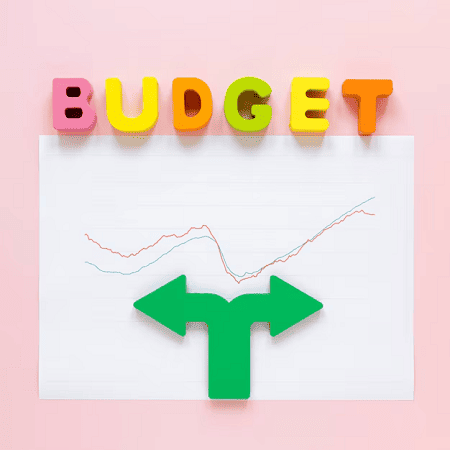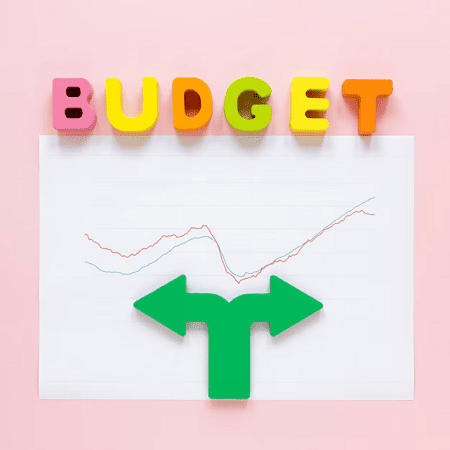Budgeting and Forecasting- Budgeting and forecasting are essential tools for individuals and organizations to manage their finances effectively. While they may sound similar, they serve distinct purposes.
Budgeting: Creating a Financial Plan
- Definition: Budgeting is the process of creating a financial plan for a specific period, usually a year. It involves estimating income and expenses to ensure that income meets or exceeds expenses.
- Purpose:
- Helps set financial goals.
- Provides a clear picture of income and expenses.
- Identifies areas where savings can be made.
- Prevents overspending and debt accumulation.
Forecasting: Predicting Future Outcomes
- Definition: Forecasting is the process of predicting future events or trends, often based on historical data and current conditions. It can involve various techniques, such as statistical modeling, expert opinions, or scenario analysis.
- Purpose:
- Helps make informed decisions.
- Anticipates potential risks and challenges.
- Identifies opportunities for growth.
- Facilitates strategic planning.
Key Differences:
| Feature | Budgeting | Forecasting |
|---|---|---|
| Focus | Current financial situation | Future trends and outcomes |
| Timeframe | Typically a year | Can vary from short-term to long-term |
| Purpose | Financial planning and control | Decision-making and strategic planning |
Export to Sheets
How to Create a Budget:
- Estimate Income: Consider all sources of income, including salary, wages, investments, and other sources.
- Track Expenses: Categorize expenses into fixed costs (e.g., rent, utilities) and variable costs (e.g., food, entertainment).
- Set Financial Goals: Determine your short-term and long-term financial objectives.
- Create a Budget: Allocate your income to various categories based on your goals and priorities.
- Monitor and Adjust: Regularly review your budget to ensure you’re staying on track and make adjustments as needed.
Forecasting Techniques:
- Time Series Analysis: Uses historical data to predict future values.
- Causal Modeling: Identifies relationships between variables to make predictions.
- Scenario Planning: Develops different potential future scenarios and analyzes their implications.
- Expert Judgment: Relies on the opinions of experts in a particular field.
Tips for Effective Budgeting and Forecasting:
- Be Realistic: Set achievable goals and consider potential unexpected expenses.
- Use Technology: Utilize budgeting apps or spreadsheets to track your finances efficiently.
- Review Regularly: Review your budget and forecasts periodically to make necessary adjustments.
- Seek Professional Advice: Consult with a financial advisor for personalized guidance.
By effectively combining budgeting and forecasting, individuals and organizations can make informed financial decisions, achieve their goals, and build a strong financial foundation.
What is Required Budgeting and Forecasting
Required budgeting and forecasting refers to the financial planning process that businesses and organizations must undertake to ensure their financial stability and success. It involves creating a detailed plan for income and expenses over a specific period (typically a year) and predicting future financial performance.
1. Planning Budgeting Forecasting: How it is done – Agicap
Key elements of required budgeting and forecasting include:
- Income forecasting: Estimating future revenue based on historical data, market trends, and expected sales. 1. Revenue Forecasting Explained | Oracle India www.oracle.com
- Expense budgeting: Planning for all anticipated costs, including operational expenses, salaries, and investments.
- Cash flow analysis: Predicting the inflow and outflow of cash to ensure sufficient liquidity.
- Profitability analysis: Estimating the potential profitability of the business or project.
- Risk assessment: Identifying and mitigating potential financial risks. 1. Minimise risks with accurate budget forecasting | OneAdvanced www.oneadvanced.com
Required budgeting and forecasting is essential for:
- Financial planning: Providing a roadmap for achieving financial goals.
- Decision-making: Informing strategic decisions about investments, resource allocation, and pricing. 1. Planning Budgeting Forecasting: How it is done – Agicap agicap.com
- Risk management: Identifying and mitigating potential financial risks. 1. 10 reasons why budgeting is essential for businesses | OneAdvanced www.oneadvanced.com
- Compliance: Ensuring compliance with financial regulations and reporting requirements.
The specific requirements for budgeting and forecasting can vary depending on factors such as:
- Industry: Different industries have unique financial characteristics and challenges.
- Company size: Larger companies may have more complex financial structures and reporting requirements. 1. Business reporting: With great growth comes great complexity… – Sage Advice United Kingdom www.sage.com
- Regulatory environment: Businesses operating in highly regulated industries may face stricter financial reporting standards.
Effective budgeting and forecasting requires:
- Accurate data: Reliable historical data and market information are essential for accurate predictions.
- Sound assumptions: Assumptions about future trends and economic conditions should be based on sound analysis.
- Regular monitoring and adjustment: Budgets and forecasts should be reviewed and adjusted regularly to reflect changing circumstances. 1. What is budget forecasting? – Cube Software www.cubesoftware.com
By following these guidelines, businesses and organizations can develop effective budgeting and forecasting processes that support their financial success.
Who is Required Budgeting and Forecasting
Required budgeting and forecasting is typically necessary for businesses, organizations, and individuals with significant financial responsibilities. This includes:
- Businesses: All businesses, regardless of size, need to create budgets and forecasts to manage their finances effectively. This helps with decision-making, resource allocation, and risk management.
- Non-profit organizations: Non-profits rely on budgets and forecasts to ensure they have sufficient funds to achieve their mission and provide services.
- Government agencies: Governments use budgeting and forecasting to allocate resources, plan for future expenses, and ensure fiscal responsibility.
- Individuals: While not as formal as businesses, individuals with complex financial situations, such as those managing investments, owning properties, or planning for retirement, may benefit from budgeting and forecasting.
Essentially, anyone who needs to plan for future expenses, allocate resources, or make financial decisions should consider budgeting and forecasting as essential tools.
When is Required Budgeting and Forecasting

Required budgeting and forecasting typically occurs on a regular basis. This can vary depending on the organization’s size, industry, and specific needs. However, common timeframes include:
- Annual budgets: Most organizations create annual budgets to plan for their finances over the next year.
- Quarterly or monthly forecasts: Many businesses update their forecasts on a quarterly or monthly basis to adjust for changing conditions and track progress toward their annual goals.
- Long-term strategic plans: Larger organizations may create long-term strategic plans (e.g., 5-10 years) that incorporate budgeting and forecasting to guide their overall direction.
- Project-based budgets: For projects with specific timelines and budgets, forecasts are typically created at the beginning of the project and updated throughout its duration.
Ultimately, the frequency of budgeting and forecasting depends on the organization’s specific requirements and the level of detail needed for effective financial management.
Where is Required Budgeting and Forecasting
Required budgeting and forecasting is typically conducted within the financial department or a designated budgeting and forecasting team within an organization. However, depending on the size and structure of the organization, it may involve input from various departments and stakeholders.
Here are some common locations where budgeting and forecasting activities take place:
- Finance department: This is usually the primary department responsible for budgeting and forecasting.
- Accounting department: The accounting department often plays a role in providing financial data and analysis for budgeting and forecasting purposes.
- Operations department: The operations department may be involved in providing input on expected costs and revenue projections.
- Sales department: Sales teams can provide information on sales forecasts and revenue expectations.
- Strategic planning department: Organizations with dedicated strategic planning departments may be involved in developing long-term budgets and forecasts.
Ultimately, the location of required budgeting and forecasting activities will depend on the specific structure and needs of the organization.
How is Required Budgeting and Forecastin

Required budgeting and forecasting is typically conducted through a multi-step process involving:
1. Ultimate Guide To Budgeting and Forecasting – Vena Solutions
- Data Collection: Gathering historical financial data, market trends, industry benchmarks, and other relevant information. 1. What Is Planning, Budgeting and Forecasting? – IBM www.ibm.com
- Analysis: Analyzing the collected data to identify patterns, trends, and potential risks. 1. What is Data Analysis? (Types, Methods, and Tools) – Couchbase www.couchbase.com
- Forecasting: Using various forecasting techniques (e.g., time series analysis, causal modeling, scenario planning) to predict future outcomes.
- Budgeting: Creating a detailed financial plan based on the forecasted income and expenses. 1. Planning Budgeting Forecasting: How it is done – Agicap agicap.com
- Review and Adjustment: Regularly reviewing the budget and forecasts to ensure they align with actual performance and making necessary adjustments. 1. 5 Keys To Budgeting And Forecasting Successfully – Datarails www.datarails.com
Specific steps may vary depending on the organization’s size, industry, and the complexity of its financial situation. However, the overall process typically involves these key elements.
Case Study on Budgeting and Forecasting

Case Study: A Small Business’s Budgeting and Forecasting Challenges
Company: The Coffee Beanery, a small, independent coffee shop in a suburban area.
Problem: The Coffee Beanery was struggling to maintain profitability. Despite a loyal customer base, the business was experiencing inconsistent revenue and difficulty managing expenses.
Analysis:
- Revenue Fluctuations: The coffee shop’s revenue was highly dependent on seasonal factors, with peak business during the colder months and slower periods in the summer.
- Expense Management: The business was facing challenges in controlling costs, particularly related to labor, supplies, and utilities.
- Lack of Forecasting: The owners had not been using any formal forecasting methods to anticipate future trends or potential challenges.
Solution:
- Implement a Forecasting System: The Coffee Beanery adopted a simple forecasting model based on historical sales data and seasonal trends. This helped them anticipate revenue fluctuations and adjust their staffing and inventory accordingly.
- Create a Detailed Budget: A monthly budget was developed, outlining expected income, expenses, and profit margins. This provided a clear financial framework for the business.
- Cost-Cutting Measures: The owners identified areas where expenses could be reduced, such as renegotiating supplier contracts, optimizing energy usage, and implementing labor-saving measures.
- Diversify Revenue Streams: To reduce reliance on seasonal sales, the coffee shop introduced new products and services, such as catering and merchandise, to generate additional revenue.
- Regular Monitoring and Adjustments: The budget and forecasts were reviewed monthly to ensure they aligned with actual performance. Necessary adjustments were made to address any deviations.
Results:
- Improved Profitability: By implementing these strategies, The Coffee Beanery was able to significantly improve its profitability.
- Enhanced Decision-Making: The forecasting system provided valuable insights for making informed decisions regarding staffing, inventory, and marketing.
- Enhanced Financial Control: The detailed budget helped the owners maintain better control over their expenses and identify areas for improvement.
Lessons Learned:
- Forecasting is Essential: Accurate forecasting can help businesses anticipate challenges and opportunities, enabling them to make proactive decisions.
- Cost Management is Crucial: Effective cost management is essential for maintaining profitability, especially in competitive markets.
- Diversification Can Reduce Risk: Expanding revenue streams can help businesses mitigate the impact of fluctuations in a single market.
- Regular Monitoring and Adjustment: Budgets and forecasts should be reviewed regularly to ensure they remain relevant and accurate.
This case study demonstrates the importance of budgeting and forecasting for small businesses. By implementing these strategies, The Coffee Beanery was able to overcome financial challenges and achieve sustainable growth.
White paper on Budgeting and Forecasting
Introduction
Budgeting and forecasting are fundamental tools for organizations of all sizes, providing the framework for financial planning, decision-making, and risk management. This white paper explores the concepts, techniques, and best practices associated with budgeting and forecasting, offering a strategic guide for organizations seeking to optimize their financial performance.
Understanding the Basics
Budgeting: A financial plan outlining expected income and expenses over a specific period. It serves as a roadmap for resource allocation and performance measurement.
Forecasting: The process of predicting future events or trends based on historical data and current conditions. It provides insights into potential outcomes and helps organizations anticipate challenges and opportunities.
Key Techniques and Tools
- Zero-Based Budgeting: Starting from scratch each year, allocating resources based on current priorities and needs.
- Incremental Budgeting: Building on the previous year’s budget with adjustments for inflation, growth, or cost-cutting measures.
- Activity-Based Budgeting: Allocating resources based on the activities or processes that drive costs.
- Statistical Forecasting: Using historical data and statistical models to predict future trends.
- Causal Modeling: Analyzing relationships between variables to identify cause-and-effect relationships.
- Scenario Planning: Developing multiple potential future scenarios to assess their impact on financial performance.
Best Practices for Effective Budgeting and Forecasting
- Involve Key Stakeholders: Ensure that budgeting and forecasting processes are collaborative and involve input from relevant departments.
- Use Reliable Data: Rely on accurate and up-to-date data to inform your forecasts and budget allocations.
- Regularly Review and Adjust: Monitor performance against budget and forecasts, making adjustments as needed to address changing conditions.
- Consider External Factors: Factor in economic trends, industry changes, and competitive pressures when developing forecasts.
- Utilize Technology: Leverage budgeting and forecasting software to streamline processes and improve accuracy.
Challenges and Considerations
- Uncertainty: Economic fluctuations, industry disruptions, and unexpected events can make forecasting difficult.
- Complexity: Large organizations with complex operations may face challenges in developing accurate budgets and forecasts.
- Data Quality: Ensuring the accuracy and reliability of data is crucial for effective budgeting and forecasting.
Conclusion
Budgeting and forecasting are essential for organizations seeking to achieve financial success. By understanding the key techniques, tools, and best practices, organizations can develop effective financial plans, make informed decisions, and mitigate risks. By embracing budgeting and forecasting as strategic tools, organizations can position themselves for long-term growth and sustainability.
[Insert relevant case studies or examples to illustrate the concepts discussed]
[Include a section on emerging trends in budgeting and forecasting, such as the use of artificial intelligence and machine learning]
Industrial Application of Budgeting and Forecasting
Budgeting and forecasting are essential tools for industries of all sizes, providing the framework for financial planning, decision-making, and risk management. Here are some specific applications across various industries:
Manufacturing
- Production Planning: Forecasting demand for products helps optimize production schedules and inventory levels.
- Cost Control: Budgeting assists in identifying cost-saving opportunities and allocating resources efficiently.
- Capital Investment: Forecasting future revenue and expenses aids in evaluating the feasibility of capital investments, such as new equipment or facilities.
Retail
- Inventory Management: Forecasting demand helps retailers avoid stockouts or excess inventory.
- Promotional Planning: Budgeting assists in allocating funds for marketing campaigns and promotions.
- Store Expansion: Forecasting sales and profitability helps determine the viability of opening new stores.
Healthcare
- Revenue Cycle Management: Forecasting patient volume and reimbursement rates aids in managing cash flow and ensuring financial stability.
- Capital Expenditure: Budgeting assists in planning for major investments, such as new equipment or facilities.
- Cost Control: Forecasting drug costs and other expenses helps identify areas for cost-saving measures.
Hospitality
- Demand Forecasting: Forecasting room occupancy and restaurant patronage helps optimize staffing and inventory levels.
- Revenue Management: Dynamic pricing strategies based on demand forecasting can maximize revenue.
- Event Planning: Budgeting assists in planning for special events and conferences.
Technology
- Research and Development: Forecasting the potential returns on research and development projects helps allocate resources effectively.
- Product Launch: Budgeting assists in planning for marketing campaigns and product development costs.
- IT Infrastructure: Forecasting technology needs helps ensure adequate budgeting for hardware, software, and maintenance.
Financial Services
- Risk Management: Forecasting market trends and economic conditions helps assess risk and allocate capital appropriately.
- Investment Analysis: Budgeting assists in evaluating the profitability of investment portfolios.
- Compliance: Forecasting regulatory changes helps ensure compliance with industry standards.
In summary, budgeting and forecasting are indispensable tools for industries across the board. They provide the foundation for financial planning, decision-making, and risk management, enabling organizations to optimize their operations and achieve their strategic goals.



